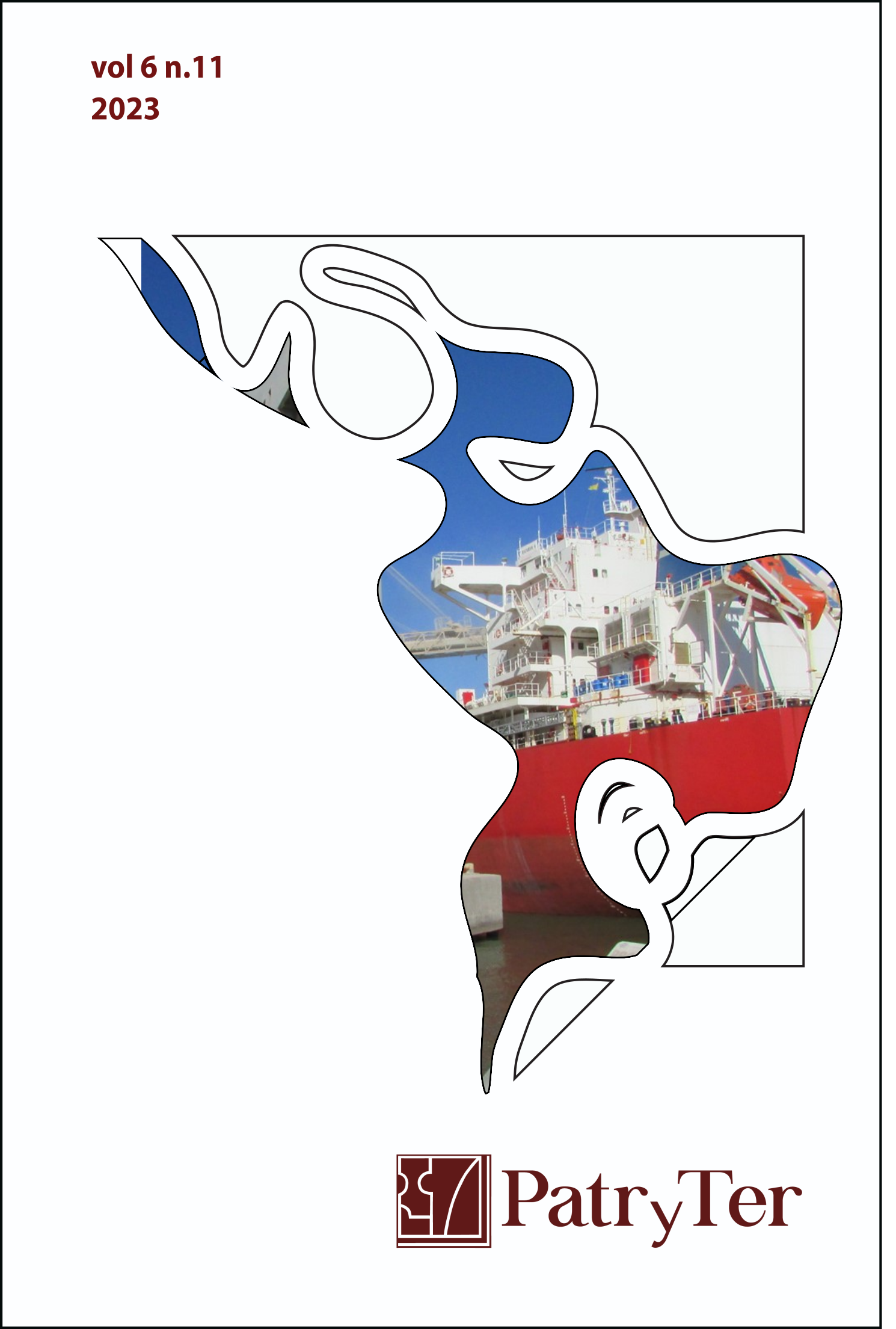Transport, road networks and emphyteusis. Urban and land structuring in Natal, Brazil (1892-1923)
DOI:
https://doi.org/10.26512/patryter.v6i11.41190Keywords:
space production. cities. networks. urban structureAbstract
During the 1910s and 1920s, the emphyteuthic legislation of Natal, capital of Rio Grande do Norte-Brazil, underwent several adjustments and changes. The land emphyteusis corroborated the urban structuring process during this period. The main objective of this study is to understand the role of roads and transport networks in the constitution of socio-spatial patterns in this emerging urban structure of Natal. The time frame focuses on the period of the Old Republic (1889-1930). The data sources used were official government reports, such as Municipal and State Government Decrees and Messages, the 1920 Brazilian Census, the Almanak Laemmert, (National Library), the 1924 Natal map and, above all, the letters from tenure of the municipality digitized by the Municipal Secretariat for the Environment and Urbanism (SEMURB) from 1904 to 1923.
Downloads
References
Abreu, M. (2014). A apropriação do território do Brasil colonial. In F. Fridman; R. Haesbaert (Orgs.). Escritos sobre espaço e história (pp. 265-298). Rio de Janeiro: Garamond.
Almanak Laemmert (1916). Annuario Administrativo, Agrícola, Profissional, Mercantil e Industrial da Republica dos Estados Unidos do Brasil para 1916. Rio de Janeiro: Companhia Typographica do Brasil.
Almanak Laemmert (1917). Annuario Administrativo, Agrícola, Profissional, Mercantil e Industrial da Republica dos Estados Unidos do Brasil para 1917. Rio de Janeiro: Companhia Typographica do Brasil.
Arrais, R., Rocha, R. & Viana, H. (2012). A Intendência e a Cidade: Fontes para o estudo da gestão da cidade de Natal (1892-1919). Natal: Editora da Universidade Federal do Rio Grande do Norte.
Beasoechea Gangoiti, J. (2007). Propiedad, Burguesía y Territorio: La Conformación Urbana de Getxo en la Ría de Bilbao (1850-1900). Bilbao: Editora da Universidad del País Vasco/Euskal Herriko Unibersitatea.
Código Civil dos Estados Unidos do Brasil (1916). Rio de Janeiro. http://www.planalto.gov.br/ccivil_03/leis/l3071impressao.htm
Cascudo, C. (1999). História da Cidade do Natal. Natal: Editora do Instituto Histórico e Geográfico do Rio Grande do Norte.
Clementino, M. (1987). O maquinista de algodão e o capital comercial. Natal: Editora da Universidade Federal do Rio Grande do Norte.
Dantas, G. (1998). Caes da Europa: o Plano Geral de Sistematização no contexto de modernização da cidade. (Monografia de Graduação em Arquitetura e Urbanismo). Universidade Federal do Rio Grande do Norte, Natal.
Ferreira, A. (1996). De la producción del espacio urbano a la creación de territorios en la ciudad: Un estudo sobre la constitución del urbano en Natal, Brasil. (Tese de Doutorado em Geografia). Universidad de Barcelona, Barcelona.
Galvão, R. (1917). Relatório apresentado à Intendência do Município de Natal, em sessão de 1º de janeiro de 1917, pelo respectivo Presidente Coronel Romualdo Lopes Galvão. Natal: Typografia de A. Leite.
Marx, M. (1991). Cidade no Brasil, Terra de quem? São Paulo: Editora da Universidade de São Paulo-Nobel.
Medeiros, G., Novo López P. & Rodriguez, N. (2016). História de três cidades: Madri, Bilbao e Natal – infraestruturas de transporte e o espaço urbano e regional (1875-1936). Insitu – Revista Científica do Programa do Mestrado Profissional em Projeto, Produção e Gestão do Espaço Urbano, 2(2), 108-132. http://revistaseletronicas.fiamfaam.br/index.php/situs/article/view/451
Miranda, J. (1999). Evolução Urbana de Natal em 400 Anos. Natal: Editora da Prefeitura do Natal, 1999.
Novo López, P. & Alonso, A. (2014). Ferrocarriles y sociedad urbana en el País Vasco. Bilbao: Editora da Universidad del País Vasco/Euskal Herriko Unibersitatea.
Ribeiro, L. (1985). Formação do capital imobiliário e a produção do espaço construído no Rio de Janeiro – 1870-1930. Espaço & Debates, 15(5), 5-15.
Ribeiro, L. (2003). Segregação residencial e políticas públicas: análise do espaço social da cidade na gestão do território. Cidades – Comunidades e Territórios, 6(4), 33-50. https://repositorio.iscte-iul.pt/bitstream/10071/3406/1/Cidades2003-6_Ribeiro.pdf
Simonini, Y. (2014). Ribeira. Técnica versus natureza. Transformações em prol de um 'projeto' de modernização (1860-1932). Natal: Editora da Universidade Federal do Rio Grande do Norte.
Downloads
Published
Issue
Section
License
Copyright (c) 2023 PatryTer

This work is licensed under a Creative Commons Attribution-NonCommercial-NoDerivatives 4.0 International License.
Please be advised that Revista Patryter is licensed under a Creative Commons Attribution-NonCommercial-NoDerivatives 4.0 International License (CC BY 4.0) https://creativecommons.org/licenses/by/4.0/
Authors who publish in the PatryTer Magazine agree to the following terms:
- Authors retain the copyright and grant the journal the right of first publication, the work being simultaneously licensed under the Creative Commons Attribution License (CC BY) which allows the sharing of the work with recognition of the authorship of the work and initial publication in this journal.
- The contribution is original and unpublished and is not being evaluated for publication by another journal. When submitting the article, authors should attach as a supplementary document a Letter addressed to the PatryTer's Editor, indicating the academic merits of the submitted work (relevance, originality and origin of the article, that is, from what type of research]. This letter must be signed by all authors.
- Authors assign the copyright of the work that they present to the Editorial Board of PatryTer Magazine, which may serve the article in the PatryTer Magazine and in public and private databases in Brazil and abroad.
- Authors declare that they are fully responsible for the entire contents of the contribution that they submit to the Editorial Board of PatryTer Magazine.
- Authors declare that there is no conflict of interest that could interfere in the impartiality of the scientific papers submitted to the PatryTer Magazine Editorial Board.
- Authors are authorized to take additional contracts separately, for non-exclusive distribution of the version of the work published in this journal (eg publish in institutional repository or as a book chapter), with acknowledgment of authorship and initial publication in this journal.
Authors are allowed and encouraged to publish and distribute their work online (eg in institutional repositories or on their personal page) at any point before or during the editorial process, as this can generate productive changes as well as increase the impact and the citation of the published work (See The Effect of Free Access).




